Are you ready to take your camping meals to the next level? Imagine adding a burst of nutrition, flavor, and versatility to your dishes, even when you’re enjoying the great outdoors, in the field, or hunkered down waiting for that unexpected event to pass.
This is our step-by-step guide on how to dehydrate frozen spinach. Dehydrating frozen spinach is real easy to do and great to have on hand for adding to any number of recipes. Besides homemade dehydrated camping meals, this works in recipes like soups, stews, pasta dishes, omelets, or casseroles.
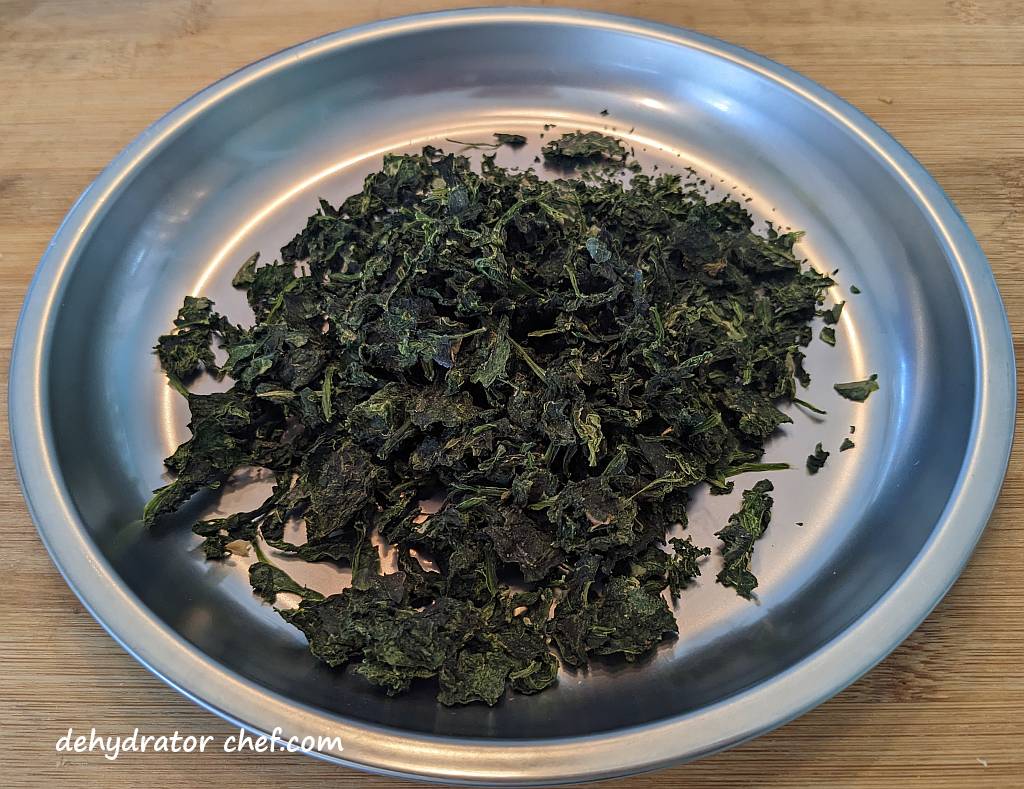
Dehydrating spinach is a simple process that can help make your homemade camping meals even more enjoyable by adding more nutrition, variety, and options.
Even if you’ve never dehydrated anything before, don’t worry, dehydrating frozen spinach is a simple process that anyone can do with just a few basic tools that we will discuss here in today’s dehydrator project.
So, whether you’re a seasoned camper, looking to up your camping meal game, or stock up your preparedness pantry with nutritious and flavorful food options, read on for our comprehensive guide.
So grab your dehydrator and let’s get started dehydrating frozen spinach.
Table of Contents
- How to Dehydrate Frozen Spinach
- Supplies Needed for Dehydrating Frozen Spinach
- Step 1. Process the Frozen Spinach for Dehydrating
- Step 2. Preparing the Dehydrator for Dehydrating Frozen Spinach
- Step 3. Dehydrating the Frozen Spinach
- Step 4. When is the Dehydrated Frozen Spinach Done
- Step 5. Equalizing and Conditioning of the Dehydrated Frozen Spinach
- Step 6. Storing Dehydrated Frozen Spinach
- Hydration
- Weights, Measures, and Serving Sizes
- Insider Tips
- Conclusion
How to Dehydrate Frozen Spinach
There are many frozen spinach options from which to choose. We are using plain frozen chopped spinach. Stay clear of frozen spinach products that are made with cream sauces. We don’t want those. Just plain ole’ chopped frozen spinach with no extras included work here.
We use dehydrated frozen spinach in many of our homemade dehydrated backpacking meals.
Sometimes we want to see the spinach leaves for the visual appeal, other times, we’re just adding powdered spinach and spinach pieces as a thickener. That said, taking the time now to make a lot of dehydrated spinach in bulk is a smart choice to create future food options.
Supplies Needed for Dehydrating Frozen Spinach
You need a good quality food dehydrator to dehydrate frozen spinach. We use the Nesco FD-75A, and you can check out our food dehydrator guide here and why we think Nesco offers the best bang for the buck. We believe this is the best food dehydrator for our long-term food storage needs.
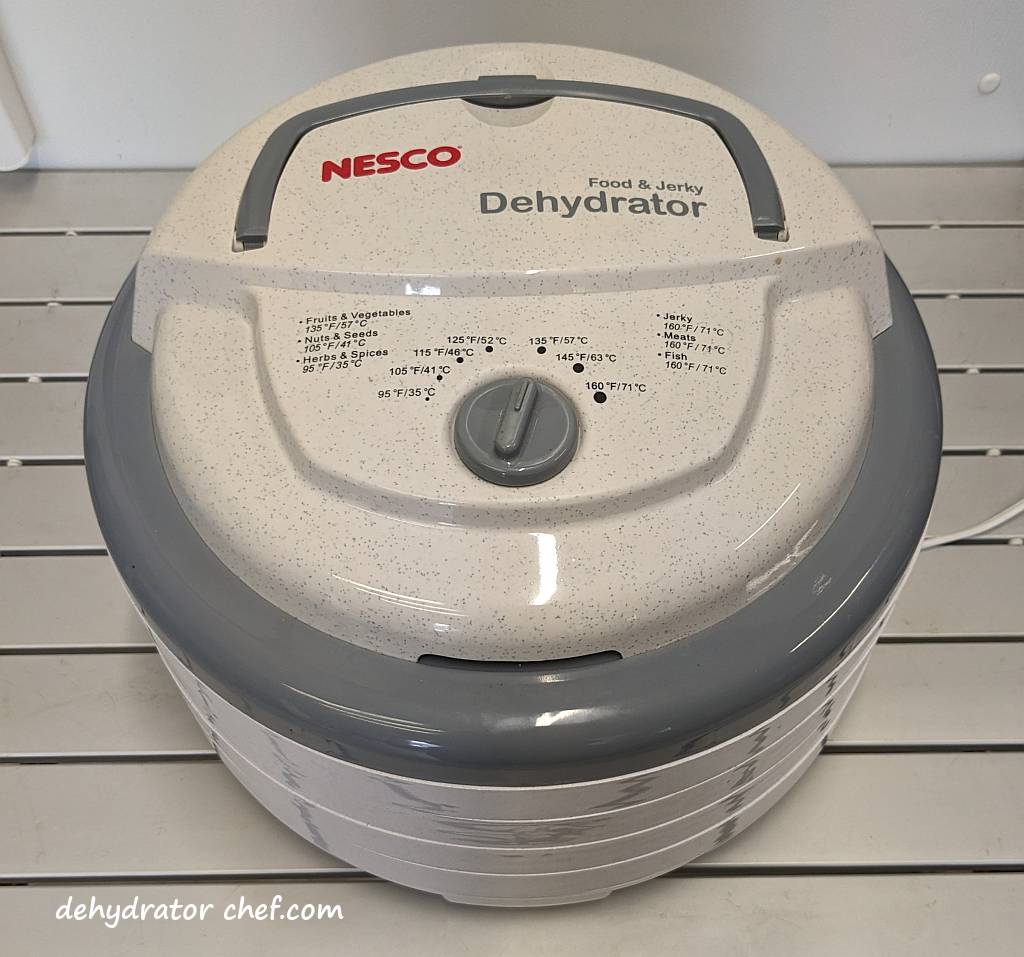
- A good quality chopped frozen spinach product
- Food dehydrator, with removable fruit roll sheet inserts for the dehydrator trays
- Wide-mouth canning funnel
- Canning jars
For planning purposes, a 16-ounce bag of frozen spinach will fill up 2 of the Nesco FD-75A dehydrator trays. Since we mostly dehydrate individual ingredients for our meals, we’ll dehydrate several bags at one time to replenish our pantry.
You’ll also need removable fruit roll sheet inserts; one will be needed for each of the dehydrator trays.
Step 1. Process the Frozen Spinach for Dehydrating
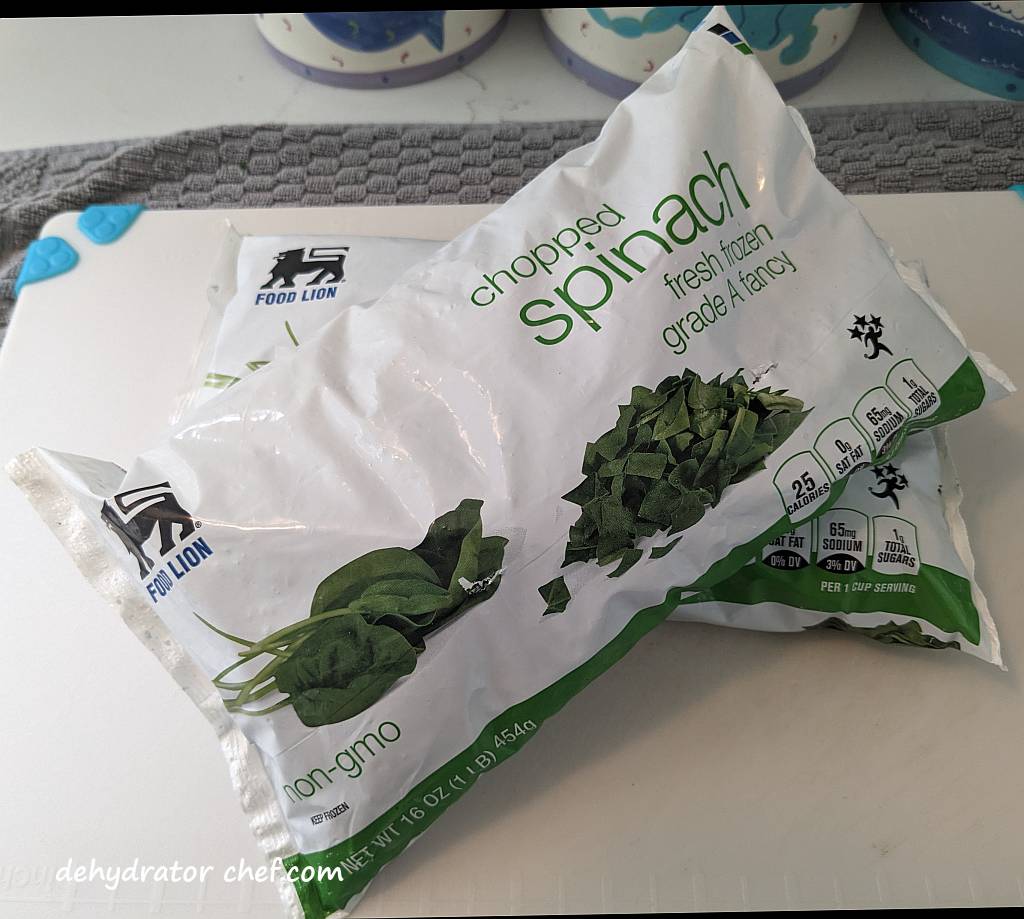
There isn’t much to do in the way of preparing the frozen spinach for dehydration. Just open the bag, then empty the contents onto the fruit roll sheets. Breaking apart any bigger pieces of frozen spinach helps prevent case hardening and also promotes even drying.
Case hardening is a phenomenon that can occur during the drying process of certain foods, including frozen spinach. It refers to the development of a hard outer crust or surface layer on the food, which can prevent the escape of moisture from the interior. This can lead to uneven drying and potentially result in moisture retention.
We’re also inspecting the frozen spinach for anything that shouldn’t be there.
Step 2. Preparing the Dehydrator for Dehydrating Frozen Spinach
One half of a 16-ounce bag of frozen spinach will fill one of my round Nesco FD-75A dehydrator trays with the removable fruit roll sheet insert.

Simply spread the frozen spinach into a consistently thin layer on the removable fruit roll sheet to promote even drying. There will likely be larger frozen spinach clumps in the bag. We can fix the clumping problem later though.
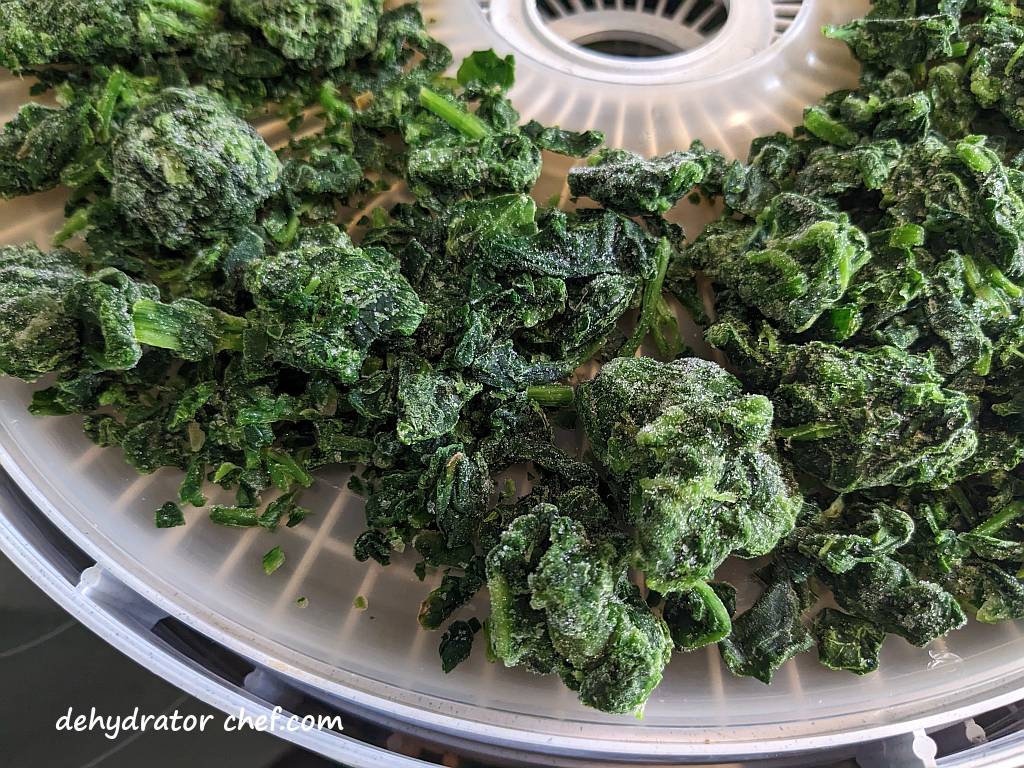
Step 3. Dehydrating the Frozen Spinach
For frozen spinach, set the dehydrator temperature to 135 °F / 57 °C. I find that 18 to 24 hours is about the right amount of time for dehydration. There is a lot of water to remove.
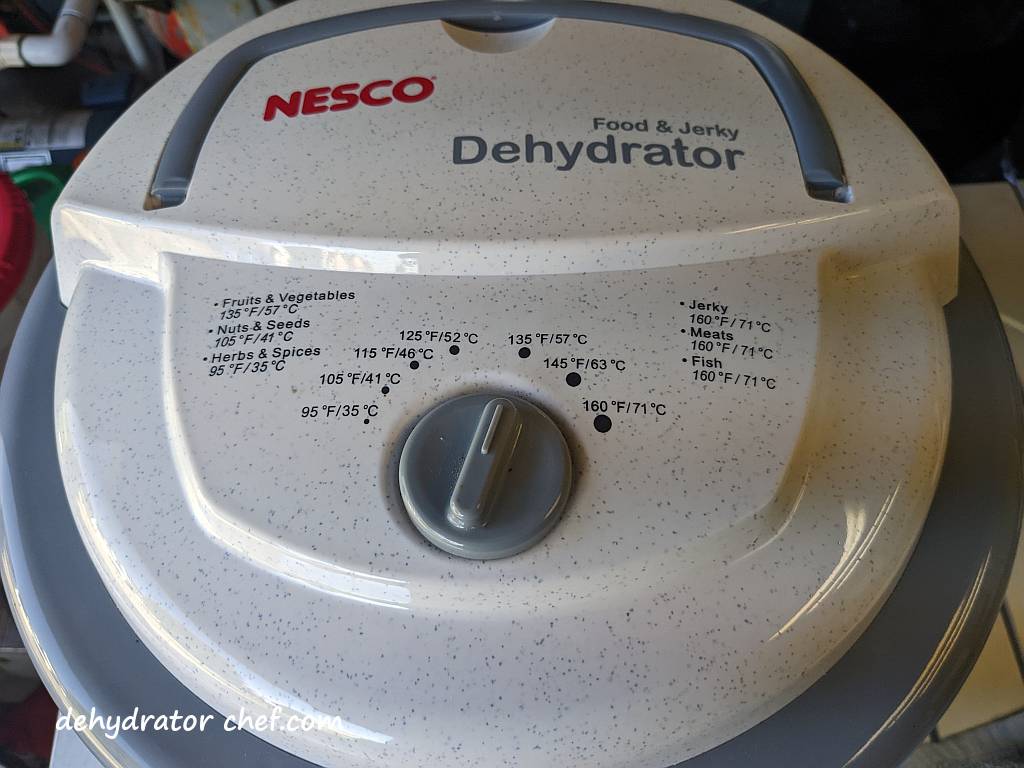
Remember to use drying times only as a guide. Of course, drying times are variable and dependent on the ambient temperature and humidity, how many, and how crowded you fill your dehydrator trays.
Case hardening is a phenomenon that can occur during the drying process of certain foods, including frozen spinach. It refers to the development of a hard outer crust or surface layer on the food, which can prevent the escape of moisture from the interior. This can lead to uneven drying and potentially result in moisture retention.
The outer layer of a frozen spinach clump may dry quickly and prevent the inside moisture from escaping, otherwise known as case hardening.
To prevent case hardening during the dehydration process, it is recommended to break apart any spinach clumps into smaller pieces about an hour after you start the dehydrator. An hour should allow ample time for the frozen spinach to thaw.
Step 4. When is the Dehydrated Frozen Spinach Done
After 18 to 24 hours, the spinach should be fully dehydrated. If not, let it go another 2 or 4 hours and check again.
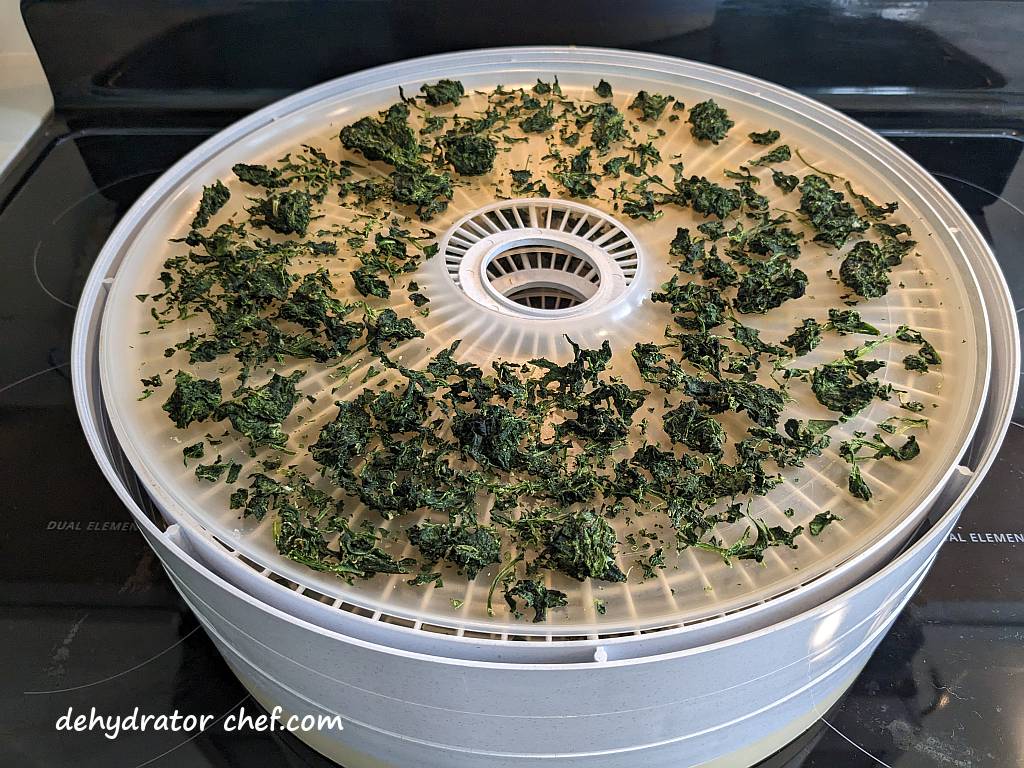
The dehydrated spinach is done with it easily crumbles. Warm spinach still in the food dehydrator may feel somewhat bendy, and you may believe it needs more drying time. Simply unplug the dehydrator and let everything cool down. Then check again to be sure. The dried spinach pieces are brittle and should easily crush and crumble into smaller pieces using your fingers when done.
Drying times will vary depending on your dehydrator. Refer to your dehydrator owner’s manual for recommended temperatures and times for dehydrating specific foods. Remember to use drying times as a guide.

Any clumps should have been broken down into smaller pieces. If any remain, break them apart, detecting for case hardening. Continue dehydrating until it’s all done.
With experience, you’ll develop an eye for case hardening, but until your dehydrator ninja skills develop, just check it all for dryness.
Step 5. Equalizing and Conditioning of the Dehydrated Frozen Spinach
We always recommend letting food items cool completely after they have finished dehydrating and before packing them into an airtight storage container for equalizing and conditioning. Warm food may cause sweating which could provide enough moisture for mold to grow.

It does not take long for dehydrated food items to start hydrating from ambient household humidity. Do not leave dehydrated food items exposed to the elements any longer than necessary because of the increased risk of mold growth.
After a short cooling period, loosely pack the dehydrated spinach into a clean, dry, insect-proof, and air-tight storage container. Don’t crush it or mash it down so it all fits into one jar. Just use a larger jar or get another. We use the larger quart-size canning jars for conditioning. Sometimes we need the larger half-gallon jars. Since the canning jars are clear, it’s easy to see what’s inside.
If you dry in bulk, invest in larger canning jars to avoid over-packing and crushing your food items. You need space in the interior of the jar to allow for mixing, rolling, and examining the contents for any mold that may have formed during the conditioning process.
A quality stainless steel or plastic canning funnel makes the messy job of getting dehydrated foods off the dehydrator tray removable inserts and into the canning jars an easy task. Take a minute or two and check them out here on Amazon.
When the dehydrated spinach pieces are removed from the dehydrator, the remaining moisture may not be distributed equally among the pieces because of their location and position in the dehydrator. Equalizing and conditioning is a process for freshly dehydrated foods that ensures any residual moisture remaining in any piece is spread, or equalized, among all the other pieces in the batch. Let the dried spinach equalize and condition in the storage container for 7 to 10 days.
Every day check the jar for moisture and roll the contents of the jar around and note any clumping or sticking. If seen, put the contents back on the dehydrator for several more hours.
If you notice any mold at all, even the smallest bit, throw it all out. What you see are the mold spores finally blooming enough to make them visible. But there are more, even tinier mold spores in the rest of your jar that make your dehydrated food inedible. Toss it out and start another batch.
Step 6. Storing Dehydrated Frozen Spinach
Use an appropriately sized canning jar for storage. The dehydrated frozen spinach might keep up to 12 months or longer. Exactly how long depends on how well you dehydrate and condition the spinach and your pantry storage conditions.
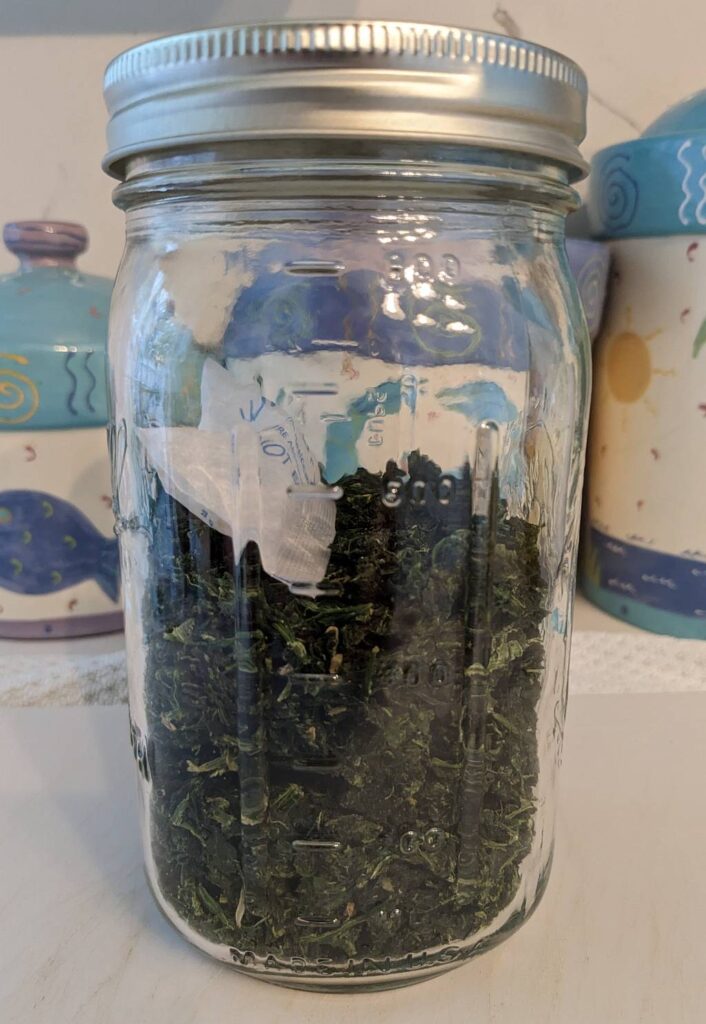
We’ll use a food-safe desiccant packet for moisture control because we live in a fairly humid area. For our pint-size or quart-size mason jars, we’ll use a single food safe 5 -gram desiccant packet. For larger jars, we’ll add 2 packets. The desiccant packets will absorb any moisture and help extend the shelf life of the dehydrated food.
We use these inexpensive food-safe desiccant packets which are available from Amazon. These 5-gram packets have over 5000 of mostly 4- and 5-star customer reviews, with an average of 4.7 stars out of 5. Our bag of 60 desiccant packets will last quite a while because they can be recharged and reused multiple times. Other food-safe sizes are available.

Lastly, I’ll attach or include a short note describing the jar contents and the date the product was dehydrated. The note also lets me know where to go in my dehydrator logbook if I want to make another note or two.
Hydration
Hydrate the dried spinach using roughly a 1-to-1 ratio of dehydrated spinach to boiled water. Plan on at least 15 to 20 minutes to fully hydrate.
If you’re supplementing store-bought freeze-dried meals as we often do, just add a bit more boiling water to the food pouch. Use the same 1-to-1 ratio of dehydrated spinach to water and account for the extra time. I find that most store-bought freeze-dried meals could use a little extra to bump up the calorie count or add more nutrition.
Weights, Measures, and Serving Sizes
This information is from a recent logbook entry on the notes we keep on most of our food dehydration efforts.
We picked up two 16-ounce bags (454 grams) of chopped fresh spinach on sale at the local grocer. Cost each: $2.39 without taxes.
One 16-ounce bag filled up 2 dehydrator trays with the removable fruit roll sheet inserts. There were quite a few frozen spinach clumps.
Trays on the dehydrator at 1130, 135 °F.
At 1300, broke apart the bigger spinach clump into smaller pieces to prevent them from case hardening.
Turned off and removed trays from the dehydrator the next morning at 0830. Let them cool for about 15 or 20 minutes.
The total dehydrated weight for both bags was 88 grams. So each package dehydrated into approximately 44 grams.
The Nutrition Facts showed there were approximately 5 servings per container, and a single serving size was 1 cup (85 grams).
Doing the math, 44 grams / 5 each 1-cup servings = 8.8 grams, rounded to 9 grams. So 1 cup = 9 grams dehydrated.
Insider Tips
Besides dehydrated meal recipes found here on this website, add dehydrated spinach to any of your favorite freeze-dried food pouches for a bit more nutrition. Spinach doesn’t have much in the way of calories.
Just be sure to compensate by adding additional boiled water in roughly a 1-to-1 ratio of added dehydrated spinach to boiling water to the freeze-dried meal and allow enough time for adequate hydration.
The primary focus of this website is dehydrating food ingredients for making homemade dehydrated meals for camping, backpacking, and prepping for unplanned events, for example, power outages. Dehydrated spinach can be a secret ingredient to get your kids to eat more veggies.
Practice at home making dehydrated camping meals using the very same gear used in the field. We practice reinforcing the skills we have learned. Practice makes perfect.
Conclusion
Dehydrating spinach is an excellent way to prepare for your camping or emergency food needs. With this comprehensive guide, you can easily dehydrate spinach using the basic tools we have talked about here. Follow these simple steps, and you will have a versatile food source that will last for a long time properly stored in the pantry.
